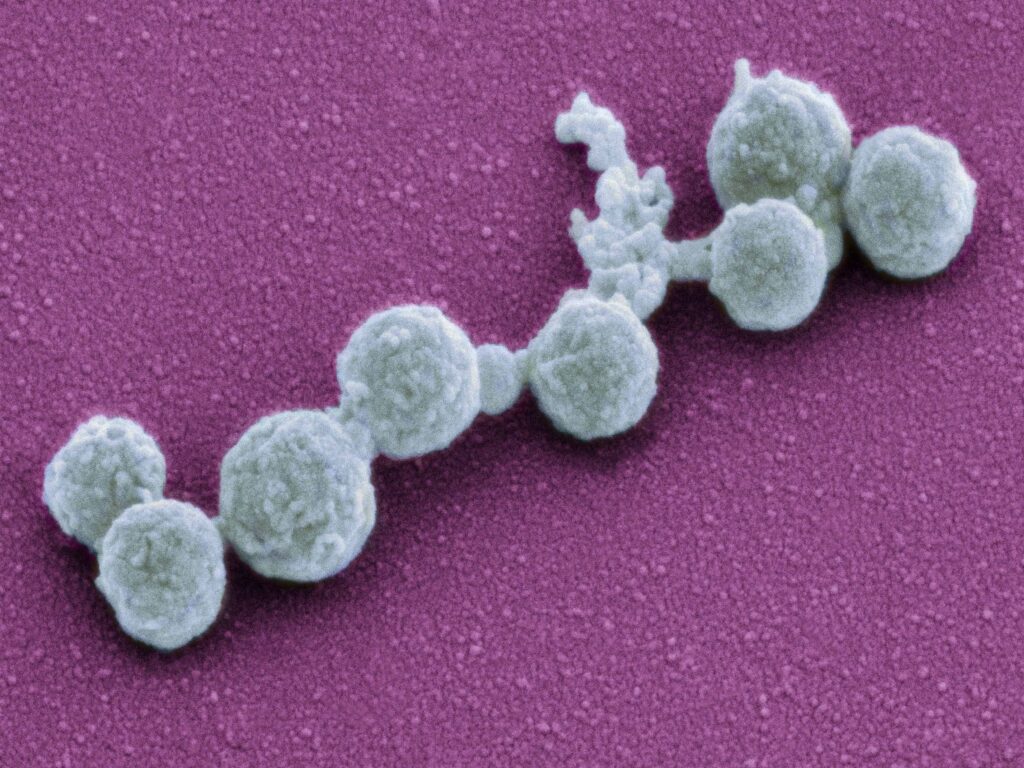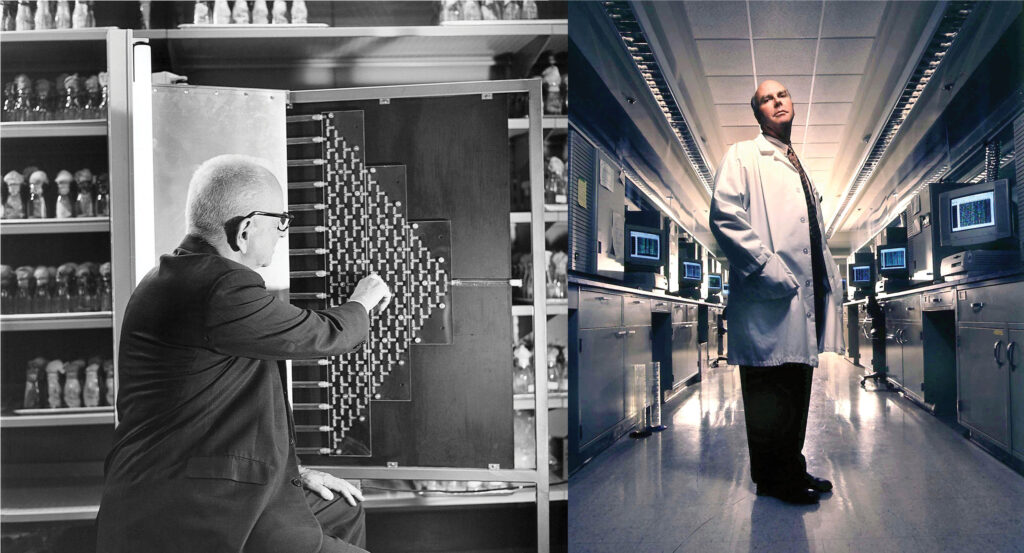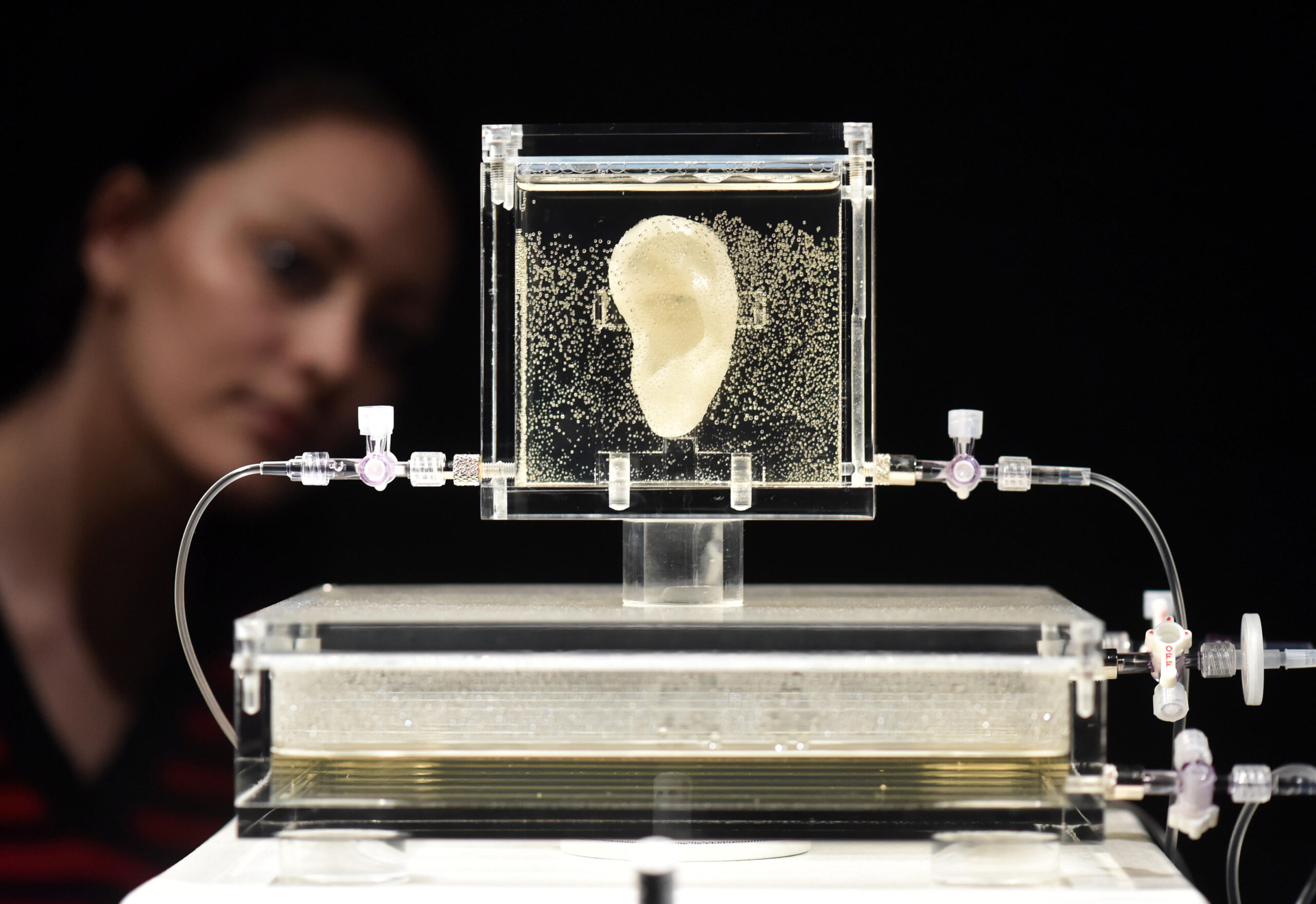Sophia Roosth. Synthetic: How Life Got Made. University of Chicago Press, 2017. 256 pp. $35.
Left scrawled on American physicist Richard Feynman’s blackboard at the time of his death in 1988 was one of the most resonant epitaphs for any scientist: “What I cannot create, I do not understand.”
That’s all very well for a physicist, who can re-create even the early moments of the Big Bang in a particle collider. But if Feynman is right, it doesn’t bode well for biologists.
Creating life from scratch is a dream as old as myth, but no one has done it—and as our knowledge deepens, the problem seems ever harder. Spontaneous generation—the idea that life can materialize abruptly from inanimate matter—was once considered a trivial, almost inevitable feat. Even in the 19th century it was widely thought life might arise through chemical synthesis: it was just a matter of finding the right composition. But with today’s emphasis on information and organization in biology, the task seems gargantuan.
Or is it? The discipline of synthetic biology regards life as an engineering challenge: organisms can be redesigned, repurposed, and perhaps even built from scratch according to the whim of the engineer, wherein living things become a concordance of parts—standardized parts, even—whose coordinated operation requires only the correct design and assembly.
Some might argue that the chemical creation of life was already demonstrated when in 2010 Craig Venter and his coworkers built a synthetic genome, inserted it into a bacterium, and rebooted the microorganism with a new “software program.”
Sophia Roosth’s survey of synthetic biology offers a welcome philosophical perspective on the question of what synthetic life is all about. Too often the discussion gets reduced to a simple dichotomy: either you agree life can only be a question of materials configured to permit information encoding and transfer, or you have to sprinkle on some mysterious fairy dust. Are you a materialist or a mystic?
Philosophers, historians, and sociologists of science have, however, the habit—infuriating to some scientists—of first demanding a careful definition of terms. Synthetic biologists, Roosth says, “retroactively define what counts as ‘life’ to accord with the living things they manufacture and account to be living.” In doing so they erect a framework for satisfying Feynman’s challenge: an ability to make life then supplies a means of understanding it. Making new kinds of living stuff, Roosth says, thus becomes a form of analysis: a way of creating and testing theories of biological systems.
Beginning in 2005 Roosth spent eight years attending lectures and seminars, conducting interviews, and generally observing the culture and discourse of synthetic-biology labs on the East and West Coasts of the United States, as well as visiting hacker groups, start-up companies, and established corporations. In particular, she hung out in the laboratory of one of the field’s most vocal and thoughtful practitioners, Andrew “Drew” Endy of MIT. The result, while it is a distinctly American-flavored version of synthetic biology (which has a somewhat different seasoning in Europe), is a curious but engaging and thought-provoking mixture of memoir, science popularization, and philosophical inquiry.
Roosth’s epiphany seems to have occurred after observing the way Endy responded to his early work on computational modeling of the bacteriophage T7, a virus that infects bacteria. His model took into account all that was then known about the virus’s genetics to try to predict so seemingly simple and fundamental a property as its growth rate. But the model failed dismally.
Most researchers would have concluded that either they had got the modeling wrong or there was still some crucial information about the virus that was lacking—in any event, that the theory had shortcomings. But Endy’s view was different. The problem, he decided, was the virus. It was too damned complicated. The modeling would work fine if the virus could be changed to fit it. “Because the model did not work,” Roosth writes, “instead of scrapping the model, Endy decided to modify the virus.”
This, she says, amounts to a conclusion that “Nature with a capital N” isn’t so interesting in itself. What matters is the ability to refashion it “as it should be.”

A colorized scanning electron micrograph of a synthetic Mycoplasma bacteria. The first self-replicating bacterial cell controlled by a synthetic genome was developed in 2010 by scientists at the J. Craig Venter Institute.
Here is the conflict at the heart of synthetic biology. For most biologists, evolution is almost sacrosanct. Through random mutation and natural selection, evolution finds the “best” solutions to life’s problems. For some researchers ideal adaptation is almost an unconscious default assumption: everything in biology is the way it is because it has been optimized for a function. Of course, evolution seems sometimes to make mistakes that become too costly to undo, such as leaving delicate DNA in the chemically reactive furnace of the mitochondria. But the modern genetic era has now destabilized this Panglossian picture to a disconcerting degree. The human genome is full of apparently meaningless “junk”; it is impenetrably complicated; and some inheritable traits seem extremely hard to attribute to specific genes. The bitter disputes over, say, the putative regulatory role of much of that junk DNA can be seen as one symptom of the ensuing “epistemic panic attack,” as Roosth calls it: a suspicion we don’t know or understand as much as we thought.
Synthetic biologists respond differently to this crisis of comprehensibility and coherence. Theirs is the perspective of the computer programmer: this coding is terrible! We need to debug it! That was Endy’s impulse with the recalcitrant T7: to rewrite its genetic code in a way that would be “wholly transparent, legible, and predictable.” What Roosth cleverly explains is while on the one hand this is just sound engineering sense applied to a new material, on the other hand it also fundamentally upsets the idealization of biology that has informed most previous popular and technical writing on the subject. Not only is biology messy and makeshift but—anathema to the engineer—it fails to observe principles that make its procedures transparent and accessible. As Endy has put it, “We’re all familiar with Darwin and the idea that evolution is cool, and it is . . . but there’s the other view of evolution—that it’s a tyrant, giving us mutation without representation.” He’s certainly astute enough to know how that will resonate around Boston’s biotech community.
Interspersed throughout Roosth’s survey of some of the key figures and greatest hits of synthetic biology—from Craig Venter’s “synthetic microbe” to Jay Keasling’s repurposing of bacterial and yeast metabolism to make the antimalarial drug artemisinin—are digressions on the prehistory of the discipline and the philosophical, semantic, and scientific debates around such concepts as naturalness, synthesis, and art. The origin of an engineering perspective on life is often traced to the German biologist Jacques Loeb at the end of the 19th century, who claimed to have “created life” by chemically inducing parthenogenesis in sea urchins. Loeb announced his program in his 1912 book The Mechanistic Conception of Life, saying, “Man can at least succeed in a technology of living substance.” But the notion of life as mechanism goes back further; René Descartes toyed with it in the 17th century, and the French physician Julien Offray de la Mettrie risked accusations of blasphemy in his Man a Machine (1747), published in a golden age of mechanical automata.
Synthetic biology, Roosth contends, undermines conventional concepts of relatedness, as transgenic hybrids and cobbled-together chimeras pay no heed to the evolutionary mechanisms that shape the phylogenetic “tree of life.” Likewise, efforts to use the methods of synthetic biology to resurrect extinct organisms unsettle the notion of life as finite, making it instead “interruptible . . . and always available for reanimation.” Whether Roosth’s bringing to bear queer theory to address these considerations is more than just a modish metaphor is a matter of taste. Perhaps it is better to say synthetic biology and queer theory both invoke the age-old contended territory of naturalness and its violation—which is why Mary Shelley’s Frankenstein emerges as a point of reference in both disciplines. Regardless, when conceptual boundaries become blurred and contentious—living/nonliving, natural/synthetic, human/nonhuman—the debate needs to be widened beyond science to acknowledge how social influences determine and police normative values and how these values may elide ought and is so that what we find in nature becomes associated with moral goodness. It’s certainly not enough for synthetic biology to claim it is “just” applying engineering to life, as though the meanings and implications of that are self-evident.
For one thing, here as elsewhere in science, practitioners of synthetic biology often make unconscious use of framing devices that have far more baggage than they recognize. Similarly, some of those who have invoked evolutionary biologist Theodosius Dobzhansky’s famous quote—“Nothing in biology makes sense except in the light of evolution”—have overlooked its theological undercurrents. (His argument hinges on an assumption about why God would make biology comprehensible.) So too synthetic biologists perform a delicate dance with biblical imagery.
They are, after all, engaged in that diabolical business of intelligent design—and their anxiety is sometimes palpable. In one telling passage Roosth recounts sitting in on a lab meeting of Endy’s group, where the atmosphere was informal, relaxed, and even a little self-consciously subversive. But then one first-year graduate student committed a faux pas as he spoke about his work: he mentioned Endy had created a T7 bacteriophage with a redesigned, decluttered genome.
The room, which moments earlier had been abuzz with questions and side conversations, fell abruptly silent. Seconds passed. Endy spoke first, in measured tones: “We don’t create biology; we construct it.”
Roosth herself received the same disapproval in an email exchange with a graduate student from the lab, who told her, “We like to avoid using the word ‘create’ in synthetic biology because of its god-like connotations and because it is not scientifically accurate.” The latter, spurious reason only shows how determined the researchers are to justify a convention evidently evolved for the purpose of image curation.

Left, Geneticist Theodosius Dobzhansky adjusts a fly maze in 1965. Dobzhansky, through his work with fruit flies, helped reconcile Charles Darwin’s theory of evolution and Gregor Mendel’s principles of heredity and was instrumental in advancing the idea that natural selection occurs through gene mutation. Right, Biochemist and geneticist Craig Venter photographed in 1998. Using a technique known as shotgun sequencing, Venter’s private venture nearly beat out a government-funded international collaboration to sequence the first human genome.
It’s probably unwise to read too much into James Watson’s famous quip, “If we don’t play God, who will?” He is not, after all, renowned for self-reflection. But when Venter’s linchpin research scientist Hamilton Smith responds to accusations of “playing God” by saying, “We don’t play,” he is clearly planting a flag. Likewise, pioneering Harvard University synthetic biologist George Church is happy to say that “we are acting as engineers, possibly as intelligent designers,” even while distancing the research from the creationism of the religiously motivated intelligent-design movement. There is a contestation of territory in progress here between those who view life as something sacred and inviolable and those who see it as an emergent, contingent, and material aspect of the physical world. That’s evident too in Church’s assertion that engineering, as something humans do well, is “natural”: there’s nothing so special about life (whether you regard it as divinely created or not) that denies us the right to alter it.
Roosth’s point is not whether these claims are right or wrong but that they make synthetic biology a richer and more complex pursuit than some of its practitioners might acknowledge. There’s no getting away from that complication, and imposing a taboo on the word creation just displaces the tension. When you seek to engineer with life, you have the weight of history and myth on your shoulders.
Roosth’s real agenda, then, is to use synthetic biology as a case study in the creation of norms and self-image in science. In a particularly insightful chapter she shows how biotech start-ups that make use of synthetic biology, while affecting the laid-back ethos of Silicon Valley, in fact embody the same kinds of labor relations and hierarchy of prestige as the rest of mass capitalism. As with some of the engineered organisms themselves, the focus is all on efficiency—achieving the most with the least expenditure of energy or other currency, leaving little room for other measures of value. This adherence to the norms of the marketplace may be challenged by the growing hacker community that is exploring synthetic biology in kitchens, garages, and community workshops, producing a de facto if not explicit critique of the aims and motives of industrial-scale science and technology. But hacker culture has its own dynamics and hierarchies, which at its worst can romanticize libertarianism at the expense of safety and responsibility.
What kind of science, then, is this new discipline? One, Roosth thinks, that does not fit the philosophy or way of thinking typical of the life sciences:
Such a characterization doesn’t make synthetic biology unique, though: in fact it aligns the discipline with chemistry. And this is precisely why I like the categorization: because it is in this process of making (most of all when it is making of life) that so many aspects neglected in the other sciences—aesthetics, ethics, values, and meanings—come to the fore. Perhaps, then, synthetic biology, while seeming to be an offshoot of the life sciences, could benefit from more dialogue with the chemists.




